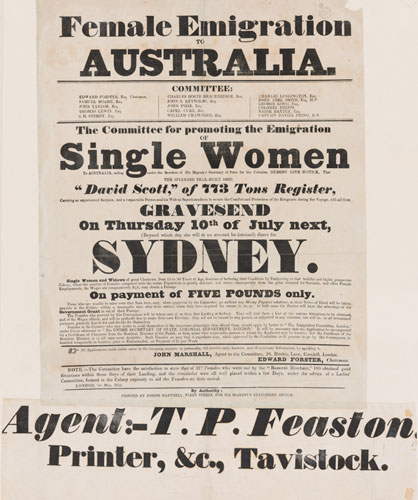Female emigration
Many migrant women who travelled to Australia made the voyage alone. Some were married and came out to the colonies on their own to join their husbands. Wealthier women purchased cabin class passages and were often accompanied by relatives or companions. Although this afforded them more freedom than travelling as a single woman, they were often still restricted to their cabins, the saloon or the poop deck. Other, poorer, single or widowed women made the journey as steerage passengers.
In the early 1800s, the colonial population was predominantly male, made up of convicts, soldiers, and agricultural workers. Recognising the need for more single women in Australia, the Emigration Commission began advertising for women in search of employment, marriage, or a new life. Initially, ships were chartered for the exclusive use of single women but later the Emigration Commission provided single women with assisted passage on standard government emigrant ships. Eligibility criteria varied, but the Commission usually only accepted single women aged between 18 and 35 who could prove their physical and moral soundness.
On board, a matron was appointed to supervise and regulate the single women’s daily lives. Deck time was limited and compartments below deck were often cramped, dark and poorly ventilated. Most ships had only one bathroom for the single women, while others had none at all.
To protect their moral character, and ensure no improper conduct during the voyage, the women were strictly segregated from the rest of the passengers at all times. How the women were separated varied between ships, but they were frequently held behind wooden barriers or ropes, and locked into their compartments at night. As a rule, the women were forbidden to talk to male passengers and crew, although some matrons allowed contact with male family members.
Like other steerage passengers, single women were organised into messes before embarkation. Under the matron’s supervision, women would eat their meals and perform their chores with other members of their mess. The ‘girls’ had to prepare meals, wash dishes and their own clothing, keep their berths clean as well as sweep and scrub floors. Sometimes women in the cabin classes would hire a single woman from steerage to help look after their children. In their spare time the women could do needlework, read, write, take lessons, attend singing classes or take part in performances.
 Female emigration to Australia, 1 May, 1834, from Proclamations,
Female emigration to Australia, 1 May, 1834, from Proclamations, 


